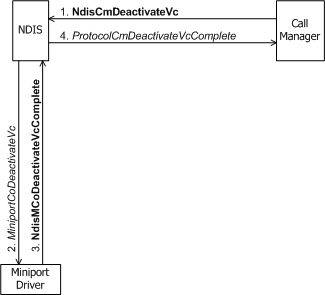Deactivating a VC
A call manager calls NdisCmDeactivateVc as an essential step in closing either an outgoing or incoming call, typically after the packet exchange with network components that tears down the call (see Client-Initiated Request to Close a Call and Incoming Request to Close a Call). An MCM driver does the same thing by calling NdisMCmDeactivateVc.
The call to NdisCmDeactivateVc causes NDIS to call the underlying miniport driver's MiniportCoDeactivateVc function (see the following figure). MiniportCoDeactivateVc communicates with its network adapter to terminate all communication across this VC (for example, clearing receive or send buffers on the adapter).

Before it deactivates a VC, the miniport driver must complete any pending transfers on the VC. That is, the miniport driver must wait until it has completed all sends in progress and until all receive packets that it has indicated are returned to it. After deactivating the VC, the miniport driver cannot indicate receives or transmit sends on the VC.
Note that MiniportCoDeactivateVc does not delete the VC. The creator (client, call manager, or MCM driver) of a particular VC that will not be reused calls NdisCoDeleteVc to destroy that VC. A deactivated VC can be reactivated by a connection-oriented client, a call manager, or an MCM driver.
MiniportCoDeactivateVc can complete synchronously or asynchronously. A call to NdisMCoDeactivateVcComplete. causes NDIS to call the ProtocolCmDeactivateVcComplete function of the call manager that originally requested the VC deactivation. Completion of the deactivation means that all call parameters for the VC used on activation are no longer valid. Any further use of the VC is prohibited except to reactivate it with a new set of call parameters.
An MCM driver's call to NdisMCmDeactivateVc informs NDIS that it has deactivated a VC or changed the call parameters on an established VC (see the following figure). NDIS completes the deactivation sequence by calling the MCM driver's ProtocolCmDeactivateVcComplete function.

An MCM driver does not call NdisMCmDeactivateVc to deactivate VCs used for exchanging signaling messages between the MCM driver and network components such as a switch. An MCM driver deactivates a signaling VC internally without calling any NdisXxx function.